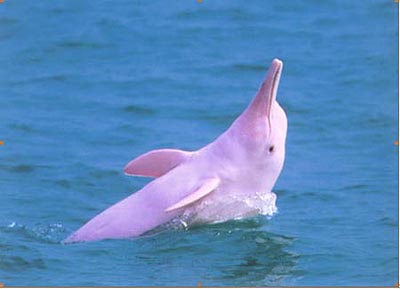|

"You really should go to see this kind of dolphin," exclaimed Doctor Lindsay Porter, a biologist researching marine life with the World Wildlife Fund, (WWF) Hong Kong. She has worked in the vicinity of the Pearl River Estuary in Hong Kong Special Administrative Regions (SAR) in China for 15 years to study the Chinese White Dolphins (Sousa chinensis), the only dolphin tagged with the name of China. Her research on this creature includes their living conditions, social life and mating and breeding patterns.
WWF Hong Kong recently launched a three-year protection project for the Chinese White Dolphins starting from August this year until 2011. Experts and scholars at home and abroad are holding joint efforts to promote the long-term continuous protection for this kind of species, which lives around the coastal waters of China.
At the ceremony to launch the project, Lindsay and Doctor Andy Cornish, WWF Hong Kong Conservation Director, also the general director of the project, introduced the current living status of the dolphins, and shared their experiences of protecting the dolphin group in Hong Kong and other places around China's mainland coastal areas.
Lack of data
Due to the fact that the pink dolphins are living in a vast coastal area, from the north- central Australia to south China, they are classed as "data deficient." This means that not enough is known about their population numbers to have them placed on the threatened species Red List of the International Union for Conservation of Nature (IUCN).
The White Dolphins around China currently mainly live in the Pearl River Estuary in Hong Kong, Sanniangwan Bay of Guangxi Zhuang Autonomous Region, the city of Xiamen in Fujian Province, west Taiwan, and Leizhouwan Bay in Guangdong Province.
Lindsay Porter began her research in waters in the Hong Kong vicinity as early as 1994, when she attempted to compile accurate data on dolphins living there.
"I have to say roughly that the number of white dolphins around the Pearl River Estuary is around 1,000, for dolphins are moving about in a vast territory, and are not likely to live in a certain fixed group," said Lindsay.
Although named white dolphins, this species lives in the vicinity of entrances of rivers, and actually exhibit pink colors after they grow up and become mature.
"A dolphin is gray after birth and becomes pinkish-gray with spots at a young age, and the spots are unique for each, so it is easy to distinguish each of them," said Andy. The adult dolphin turns pinkish white, a color similar to that of a pink flying elephant in an animated cartoon film, according to him. "We may have named it 'pinkish white dolphin' if we had communicated with other researchers, then the species would draw more attention," he said with a sense of humor.
The Chinese White Dolphins are not as recognizable to people as big pandas, snub-nosed monkeys and red ibis, though all of them are under the first-class protection of the state. However, fishermen living around the seaside of Southeast China, have a very deep affection for this kind of sea animal. They named the sea species 'Mazu', meaning Goddess of the sea.
The pink dolphins frequently appearing at the sea areas near Hong Kong were chosen as the mascot when the SAR's sovereignty returned to China's mainland in 1997.
"Among many kinds of whales and dolphins I have studied, the Chinese White Dolphins living waters in Hong Kong have always caught my attention," said Lindsay. "It's really great for them to live in such a robust sea which is full of transportation ships," she said. Lindsay puts their survival down to their unique independent character.
The dolphins have their own social life. "The newly mature young dolphins like to drop around different dolphin families, displaying their innate nature of sociality," she said. She also found that the white dolphins exhibit human kindness. After growing up, male dolphins leave the family, but females stay to help their mothers to take care of their infant brothers and sisters. Lindsay has seen a young dolphin helping a baby dolphin to have a breath out of water.
In the perception of Lindsay, this kind of dolphin has developed a fairly strict social structure due to the fact that they have long been living alongside human beings. "They need to take advantage of their unique social structure to share some resources in the sea, which is a special feature of this creature," she remarked. Her study suggested that no other kind of dolphins
| 